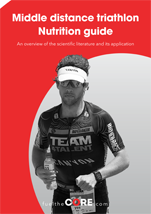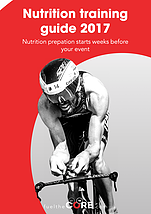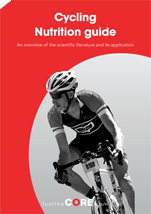Long distance triathlon nutrition guide
An overview of the scientific literature and its application.
For a long distance triathlon or other 8 to 16 hour event, nutrition can be an incredibly important factor. In shorter distance triathlons you may be able to get away with making some nutrition mistakes, but during a long distance triathlon you will be punished for nutrition errors. In this sport nutrition can be the difference between winning and not finishing! When you talk to athletes who did not have a good race, they will often mention nutrition as the main reason why things did no go as planned.
On this page the basics of nutrition are discussed: a few general rules of nutrition and some of the most common mistakes.
Three main nutritional issues
The three most important nutritional issues during a half distance triathlon are:
- Meeting the man with the hammer: Running out of fuel, hitting the wall, bonking, or just not being able to keep up the intensity during the last part of the race.
- Dehydration: Becoming progressively dehydrated to an extent where this will limit performance.
- Stomach problems: Gastrointestinal problems such as stomach cramps, bloating, etc. that can have a negative impact on your performance.
The first problem (running out of energy) can be avoided by making sure there is enough fuel in the tank at the start and that you top up enough during the event. Hydration is similar, you need to drink enough, but not too much! Then there are several ways to prevent an upset stomach, some of these start days before the race!
Carbo-loading
Carbo-loading is a technique that aims to optimize carbohydrate stores often in the days leading up to an event. For a long distance triathlon no extreme carbohydrate loading is required. It is important to go to the start with carbohydrate stores full (and definitely not depleted), but this can be done by eating a normal amount of carbohydrate (The day before a meal that contains pasta, rice, or potato would work well). It is not necessary to eat large amounts. You want to go to the start line nice and light but with enough energy!
Breakfast
Breakfast is probably one of the most important parts of nutritional preparation for a long distance triathlon. Ideally a breakfast is consumed 3-4 hours before the race and contains at least 100 and up to 200 grams of carbohydrate and has a low fiber content (especially for those who often get stomach problems). Good sources of carbohydrate for breakfast, that are very easy to digest, include white bread with jam, bagels, cereals that are low in fiber, and if stomach and intestinal problems are never an issue, oatmeal and muesli. A good breakfast makes sure that carbohydrate is stored in the liver and this will make sure blood sugar does not drop during your long distance triathlon.
Fueling
The main fuel for an event like this is carbohydrate, especially if you are completing the race closer to the 4 hour mark than the 7 hour mark. Your body stores contain roughly 500 grams of carbohydrate (this is 2000 kcal), not enough to make it to the finish line. In theory it should be enough to get most athletes through the first 3 hours of a race but topping up from the start is essential. Because it takes time for carbohydrate to be absorbed, you need to start early with fueling to make sure you avoid carbohydrate depletion. Once you run out of carbohydrate stores it is difficult to recover.
As a general rule, aim for 60 grams of carbohydrate per hour. This carbohydrate can be in the form of a bar, a gel, chews, or a drink. If you use solid foods, make sure fat, protein and fiber content are low (no more than a few grams). What you use is entirely up to you and your personal preferences. Faster athletes tend to use more liquids and less solids because it can be difficult to chew at high intensities.
To give you some idea of what 60 grams per hour equates to, it means that for every hour of the race you would need one of the following combinations:
- 2 gels and a small amount of sports drink;
- 1 gel and a bottle of a sports drink;
- 1 energy bar and half a bottle of a sports drink.
For more accurate calculations check the food labels of the products you are going to use for exact amounts.
The experienced athlete with knowledge of multiple transportable carbohydrates may try higher levels of carbohydrate intake in training and if that works use this experience to plan their race nutrition.
Hydration
“Drinking to thirst” is a recommendation that works fine for the slower athlete. If you are going a bit faster it is better to go in with a plan. It is good to use the early parts of a race when the gastrointestinal tract is working fine to absorb both carbohydrate and fluid. Later in the race, even though you may be thirsty, the gut may not absorb as much. Don’t drink excessively and use common sense. The goal should be to lose a little weight (3 to 5 pounds or 2-3 kg) at the finish line. You definitely want to avoid weight gain, which clearly would be a sign of drinking too much. In hot environments dehydration can definitely be a very important factor. Don’t forget that good hydration starts before the race, and hydrate well in the days leading to your race.
Gastro-intestinal issues
A large percentage of athletes, approximately 30 to 70 percent, experience gastrointestinal problems during long and half distance triathlon. Some of these problems are very minor but some of these may be so severe that they will affect performance. Some athletes are more prone to develop these problems than others. The complaints may be totally independent of food intake and sometimes they may only happen on race day. This suggests that “race day anxiety” has something to do with it. Studies have also shown that factors like fiber intake, fat intake and the use of very concentrated carbohydrate drinks are causes of gastrointestinal discomfort.
Planning and practicing
So combining these three main issues, you need to plan ahead and have a rough idea where you are going to get your carbohydrate from (drinks, gels, bars), how much fluid you need to take in and where you are going to get this from (carry, special needs for feed stations) and make sure you reach approximately 60 g/h of carbohydrate intake and enough fluid to not lose a lot of weight. You can get a good idea by weighing yourself before and after training. Think about this in advance and use CORE to plan your race nutrition. If you are experienced and have practiced with multiple transportable carbohydrates and intakes over 60 g/h, you could try to increase intake to 90 g/h. There are benefits associated with this but also risks, so you need to practice and make sure you use the right carbohydrate blends! 90g/h with the wrong carbohydrates and unpracticed is a recipe for disaster! Many pros aim for even higher, up to about 110 g/h.
Common mistakes on race day
The most common mistakes are:
- Not having a plan and hoping for the best. Sometimes this approach works...
- Having a plan but sticking to a plan at all costs: If for some unforeseen reason you cannot follow the plan (you lost a bottle, or you are developing gastrointestinal problems), do not continue with the plan at all costs. Be flexible and adapt. A slightly lower intake is not going to be a problem, forcing more nutrition in will.
- Experimenting on race day: Sometimes you’ll see athletes walk around on expos, buying new products for the race the next day. Only use products that you have tried and tested, products you know you tolerate well.
- Thinking that more is better: Drinking more and eating more is not always better.
Sure, you have to take in enough energy and enough fluids, but once you achieve the basic needs, more is not necessarily better and in some cases detrimental.
A couple of extra points
- Sodium losses in a race like this are unlikely to affect performance in the vast majority of athletes, so sodium supplementation should not be a priority. Too much might cause gastrointestinal problems.
- Caffeine (low dose: 3mg/kg one hour before: equivalent of a big cup of coffee or 2 espressos before the start) may help some athletes. Some athletes like it, some don’t. Experiment in training and find out what works for you.
Author
Professor Asker Jeukendrup is a leading sports nutritionists and exercise physiologist who spent most of his career at the University of Birmingham (UK) and currently he is a visiting professor at Loughborough University. During his career Professor Jeukendrup authored over 200 research papers and book chapters...





